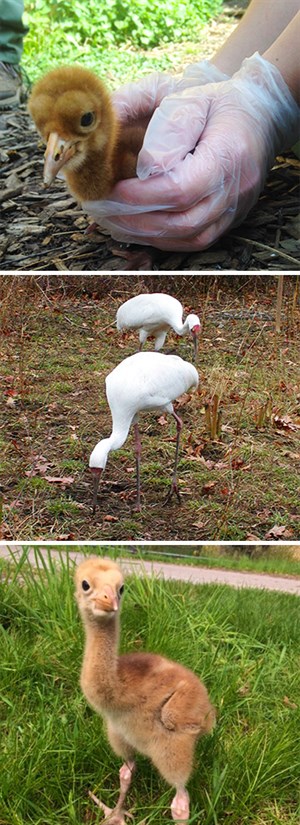Franklin Park Zoo celebrates the hatches of Siberian cranes
Friday May 20, 2016
 The staff at Franklin Park Zoo has double the reason to celebrate following the recent hatches of two endangered Siberian cranes.
The staff at Franklin Park Zoo has double the reason to celebrate following the recent hatches of two endangered Siberian cranes.
The female chicks, hatched on April 22 and 24, are the offspring of Sneetch, age 22, and Shakti, age 24. The older chick is being raised by its parents, while the younger chick is being raised by the Zoo’s Animal Management staff. While possible, it is uncommon for any crane species to successfully rear two chicks. For the younger chick’s survival, it was decided that staff needed to intervene after the parents showed little interest in attending the second egg after the first had hatched.
“Every successful hatch is important as it helps to hedge against this species’ extinction,” said Fred Beall, Zoo New England General Curator, who added, “With any new birth or hatch, there is always risk but we are hopeful that these new chicks will continue to thrive and will contribute to the survival of their species.”
In the wild, Siberian cranes breed in the high Arctic regions of Siberia. These birds, which are critically endangered, stand about 5-feet tall and are noted for their pure white plumage and black flight feathers. It is estimated that only 3,000 of these birds remain in the wild.
There are only 22 Siberian cranes in captivity in four North American institutions accredited by the Association of Zoos and Aquariums. Franklin Park Zoo, the only zoo to exhibit these birds on the East Coast, is home to seven Siberian cranes including the new chicks. Since 1999, there have been 10 chicks, including the newest chicks, hatched at the zoo.
This success is the result of a lot of hard work and technical expertise. The chicks at Franklin Park Zoo are the result of artificial insemination. The chicks’ parents, a breeding pair, have resided at Franklin Park Zoo since 1996. Because these birds hail from the high Arctic regions, each year on February 14 the Zoo staff increases the amount of light in the birds’ exhibit by one hour a week to simulate the light cycle in their native environment. The light is increased until the birds receive 21 to 22 hours of light a day. Once the light cycle reaches this point, the birds typically begin breeding. Franklin Park Zoo is the first zoo in North America to have successfully bred these birds.
Visit our Animals Section to learn more about Siberian cranes.
Bottom image courtesy of Kelly Miklavcic

